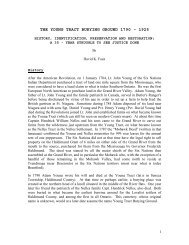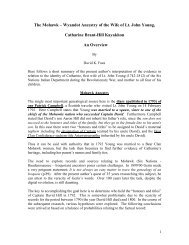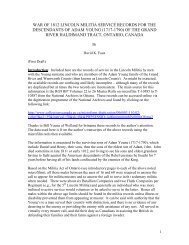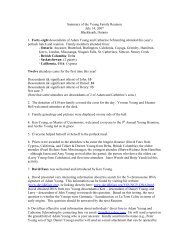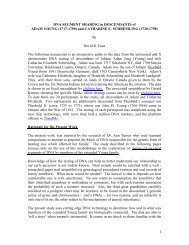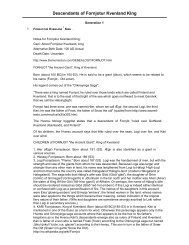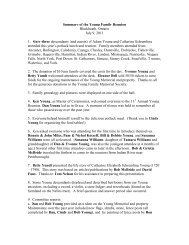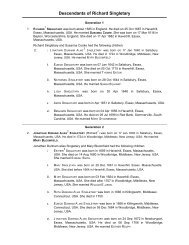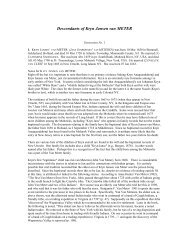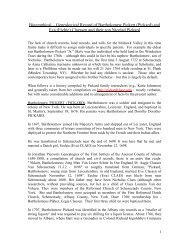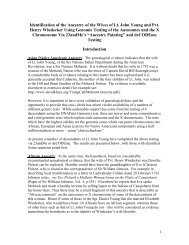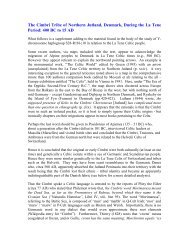Justinius attributed Caepio’s later misfortunes to the wrath of Appolo since the veneratedvaluables were once again disturbed (Cunliffe, 1997).The archaeological data supports the historical record in that there is a sudden influx ofDanubian artifacts (in other words a back migration) during the 3 rd Century BC in thewest as far as southern France – and north to the Belgae lands and Jutland. Hence it islikely that both the Tectosages of Toulouse, groups of Belgae, the Cimbri and otherunnamed tribes headed west shortly after 279 BC to establish themselves in otherlocations or those previously vacated. It is interesting to note that the respected authorHubert (1934) stated during the La Tene period, until about 300 BC, there was littleevidence of cultural equivalency in the artifact assemblage or burial customs betweenthose residing in Northern Jutland and Central Europe. However by this date what isseen in Jutland becomes more and more what one would find in the Alpine regions to thesouth.Actually, in the late La Tene period of 200 BC to 1 AD, a particularly Celticphenomenon, with a wall and ditch enclosure, has been found from the Atlantic coast ofFrance to Bohemia – the lands of the historical Central European Celts, but with thelargest number to date being found in southern Germany with 200 plus sites in Bavariaand Baden-Wurttemberg. These are the mysterious Viereckschanzen found outsidefortified settlements are now interpreted as ritual cultic sites, where possibly sacrificesand other activities were presided over by the “Celtic clergy”, the Druids (Maier, 2000).Again this phenomenon appears to reflect a cultural continuity that corresponds to thehistorically attested Celts with their epi-center in the region encompassing the headwatersof the Danube and Rhine Rivers.Konstam (2003) considers the La Tene “Celtic homeland” to have, originallyencompassed parts of the Czech Republic, Hungary, Austria, Switzerland, and southernGermany (p.20). Three foci noted by Cunliffe relating to the La Tene Celts are theMarne (eastern France), Moselle (western Germany), and Bohemian (Czech Republic).Haywood (2001) adds that at a later date the primary tribal areas corresponding to theseclusters are, respectively, the Parsii, Treveri, and Boii (see p.37). By the 4 th Century BCthere was strong cultural continuity between Celtic areas of France, Switzerland, Italy,Southern Germany, Austria and Bohemia. By the mid 3 rd Century there were twodivisions, the western (e.g., Switzerland) and eastern (eastern Alps to Transylvannia).It should be noted that as the centuries unfolded the apparent separation of CentralEurope into Celtic tribes in the south and German tribes in the north blurred to a degreeespecially in border areas and with the continued push of the Germanic tribes to thesouth. For example, late in the 1 st Century AD, just before the Romans established theLimes (defended border), and the provinces of Germania Superior and Inferior, theGermanic Batavi, and the Celtic Treveri under Julius Classicus and Julius Tutor with theCeltic Lingones led by Julius Sabinus, attempted to establish an independent Gallo-Germanic empire on both sides of the Rhine (Maier, 2000). Also we will see that theAllemanni, the prototypic German group of the 4 th Century AD, was likely an amalgamof Celt and German. A circa 400 AD medical compendium, De medicamentis, includes10
herbal remedies and magical formulae, which are wholly or partially preserved inGaulish (Maier, 2000, p.103). Circa 470 AD Sidonius Apollinaris noted that the localArverni of Gaul still spoke the Celtic language. However, within a hundred or so yearsor so of the latter date it appears that few in any Central European Celts could speak thelanguage of their ancestors, and the Celtic cultural features dissipated to the point ofbeing largely unrecognizable (the demise being well described by Collis, 2003).General direction of La Tene Celtic migration from circa 400 BCIn the above map the La Tene Celtic homeland is shown in yellow. The dark greenrepresents some limited cultural and perhaps folk movements to the west, plus regionswhere other cultures which spoke what are today known as Celtic languages, but whowere not at the time known as Celts (not until the 16 th Century was the term applied tothe insular people who spoke Goidel or Gaelic). The light green depicts expansion areaswhere La Tene Celts settled, according to documentary sources, and where theirdescendants could be found today. The continuity is reflected in many archaeologicalassemblages such as, the occurrence of Attic Red Figure Ware dating to the fifth centuryBC turning up in graves in northern France and southern Germany, such as KleinAspergle in Baden-Wurttemberg, or Somme Bionne in Champagne (Collis, 2003, p.78).These rather specific regional links may extend back thousands of years, for example thatbetween the Languedoc and southern Germany; while the cultural links of Provence aremore clearly with the peoples of the Swiss plateau (Collis, 2003, see p.177).11



